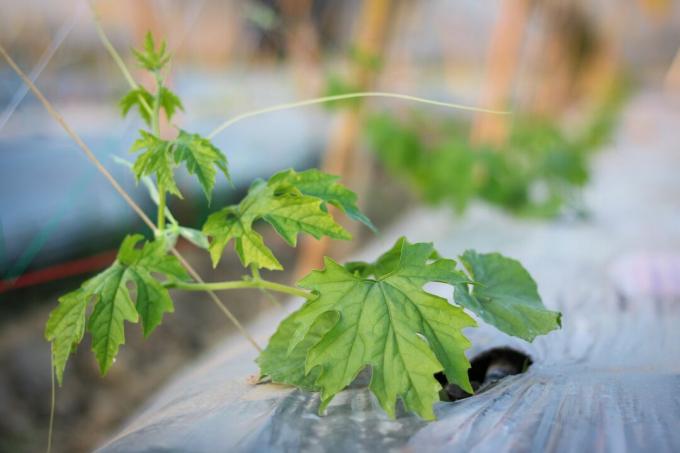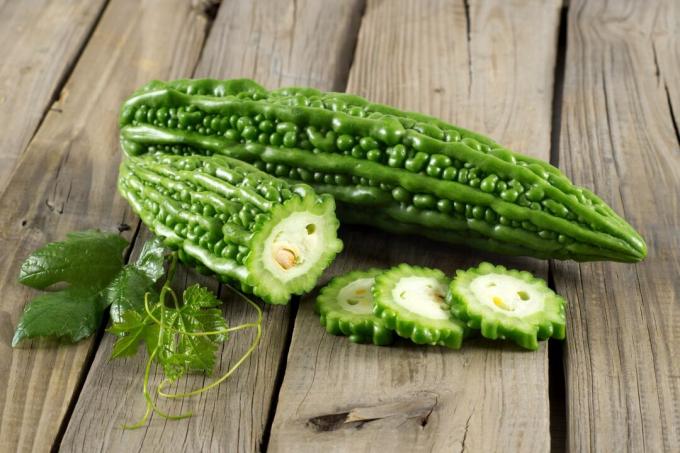The tropical fruit of the bitter melon, also called bitter gourd, has an unusual appearance and is used as a vegetable in the countries where it is grown. The plant even plays a role in traditional medicine.

Since the growing areas of the bitter melon (Momordica charantia) are located in the hot and humid tropics, cultivation in our climate is not entirely uncomplicated. In this article you will find out how you can grow the bitter gourd in your own garden and what effect and possible uses the vegetable has.
contents
- Bitter melon: origin and properties
- Plant bitter melon and grow it yourself
- The right care
- Harvest, effect and use of bitter gourd
- Are bitter melon poisonous or edible?
Bitter melon: origin and properties
In addition to bitter cucumber, bitter melon is known under the synonyms balsam pear and Goya cucumber. It belongs to the pumpkin family (Cucurbitaceae). India and China are the countries of origin of the plant, but it is now cultivated as a crop in Africa, parts of Asia, South America, the Caribbean and Europe.
The bitter melon is a herbaceous climbing plant whose pentagonal shoots can reach a length of up to 5 m. Since the gourd is not hardy, we only cultivate it once a year - in the tropical regions, on the other hand, the bitter gourd can also be perennial. The shoots and leaves are covered with light to dense hairs. The alternate arranged foliage has 3 to 7 lobes and is divided deeply palmate. The bitter melon climbs up with the help of thin, long tendrils.
The plant bears male and female, fivefold flowers with a double perianth, which are each individually in the leaf axils. They shine in a light yellow from June to August. The fruits of the bitter gourd are oblong, oval and can grow up to 10 cm long. At the beginning, the unripe berries are still green in color - later on the color changes to a bright yellow-orange. The surface of the fruit is heavily studded with nubs. When ripe, the bitter melon opens to reveal the seeds, which are encased in sticky red flesh.

Plant bitter melon and grow it yourself
The location of the bitter gourd should at best be sunny and warm and humid. Outdoor cultivation can certainly be considered in mild or warmer regions. The cucumber plant can also be cultivated in a suitable location in larger pots with a capacity of at least 10 l. Otherwise, the heat needs of the plant can be met in a greenhouse. The climbing plant stops growing at temperatures as low as about 10 °C and eventually dies. It is also important that the soil can store moisture well and is rich in nutrients and humus.
The bitter melon is easy to grow from seed and is rarely commercially available as a young plant. We will explain step by step how to grow bitter gourds:
- Time early/mid April
- Soak the seeds in lukewarm water for a few hours
- Fill pots with seed compost
- Sowing depth about 1 cm
- Keep substrate constantly moist
- Place pots in a warm, bright place
- Germination temperature 20 – 23 °C
- germination time approx. 2-3 weeks
- Planting from mid-May

The right care
Since the bitter gourd is one of the heavy consumers, the constant supply of nutrients plays an important role in care. A liquid fertilizer for vegetables is suitable for this, which can be administered about every one to two weeks with the watering. Our Plantura Organic Tomato & Vegetable Fertilizer is an example of a highly effective, sustainable and purely organic liquid fertilizer. The increased potassium content supports, among other things, the desired fruiting of the plant.

Plantura Organic Tomato & Vegetable Fertilizer
Highly effective organic liquid fertilizer
with an NK ratio of 4-5
for all types of vegetables & berries,
safe for pets and garden animals
The medium to high water requirement of the bitter melon must also be taken into account. Especially in the greenhouse or the bucket culture must be watered more often. When the top layer of soil has dried, you should water again. However, the soil must not be prone to waterlogging. Although the climbing plant can be cultivated prostrate on a layer of mulch, it is advisable to climb the bitter gourd on a trellis. When planting in pots, such a climbing aid must be provided right at the beginning.
When the tendrils of the plant have reached a length of about 80 to 100 cm, the side shoots behind the first set of leaves can be removed. This promotes the formation of shoots and fruits.
Tip: In order to be able to obtain seeds from the fruits of the bitter melon, they must be fully ripe. After harvesting, the seed coat around the kernels has to be removed and the remains washed off. Finally, the seeds can be dried and stored.
Harvest, effect and use of bitter gourd
About two to three weeks after flowering, the first unripe fruits of the bitter gourd can already be harvested. They are harvested at this stage, as the bitter taste is not quite as pronounced here as it is in the ripe state due to the bitter substances they contain. In addition, the skin becomes harder as it matures and regular harvesting of the plant stimulates flowering. Not only the unripe fruits are consumed, but also the ground seeds as a spice, the steamed leaves and young sprouts as vegetables and the sweet, red flesh of the ripe fruit used. Before preparing the bitter melon, we recommend salting the sliced fruit and washing it off after about 15 minutes or simply blanching it. This significantly reduces the bitterness. Examples of recipes with bitter gourd are various salads, soups and curries. But the bitter melon is also used individually fried, filled or pickled.

Some positive effects are attributed to the bitter melon, which is why it is sometimes offered as a dietary supplement. However, there are only a few studies that have scientifically proven these effects. These include the lowering of blood sugar levels, the influence on lipid metabolism, which helps against obesity, and the effect against worm infestation. Furthermore, the ingredients of the bitter gourd are said to inhibit inflammation and have a stomach-strengthening effect. Since an overdose of preparations made from bitter melon can also lead to undesirable side effects such as Hypoglycaemia can occur in diabetics, the intake should be coordinated with a doctor in this case will. It can also cause stomach pain, diarrhea and cramps.
Are bitter melon poisonous or edible?
Because of the partly toxic ingredients and bitter substances in the bitter melon, it is not very well tolerated when raw. Therefore, the fruit should be boiled, steamed or fried before consumption. Pregnant women, women who want to have children or breastfeeding women should refrain from consuming the bitter gourd completely, as individual ingredients have a teratogenic effect.
What is the taste of bitter melon? The bitter taste of the bitter gourd is characterized by the bitter substances and is therefore tart and bitter. In contrast, the red flesh that wraps around the ripe seeds tastes pleasantly sweet.
Another special pumpkin plant whose fruits have another interesting use besides being eaten as a vegetable is the Loofah cucumber (Luffa aegyptiaca). In our special article we will tell you how you can use the plant to produce sustainable cleaning sponges in your own garden.
...and receive concentrated plant knowledge and inspiration directly in your e-mail inbox every Sunday!


